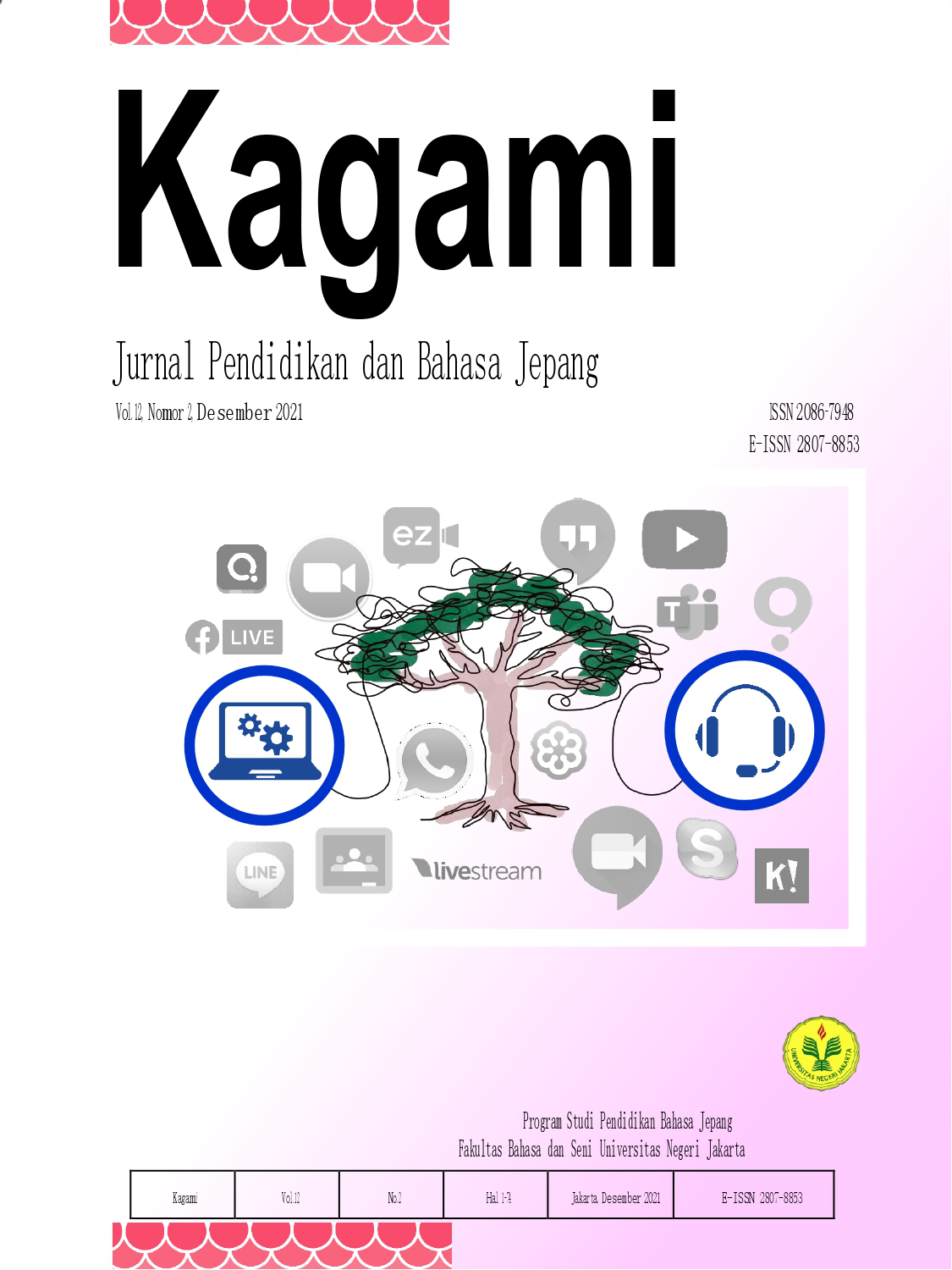MAKNA DAN FUNGSI ADVERBIA DOUMO DALAM KOMIK BAHASA JEPANG
DOI:
https://doi.org/10.21009/kagami.141.03Keywords:
Meaning and Function, Adverb Doumo, ComicAbstract
Abstract : The purpose of this paper is to find out the meaning and function of the adverb doumo (どうも) in Japanese comics. This is motivated because the word doumo (どうも) when translated has several meanings and several functions in Japanese sentences. The meaning and function of the adverb doumo in comics is analyzed based on the theory put forward by Nakamichi (1991) in Koike, Tobita and Asada (1994) in Koike, and Mulya (2013). The method used in making this paper is descriptive qualitative method. The results of the study show that all the adverb functions doumo (どうも) appear in the comic except for the interjection function (どうもね). Meanwhile, the meaning and function of the adverb doumo (どうも) is determined based on the context of the sentence. From the results of the analysis, the most frequent meanings and functions of doumo (どうも) are expressing gratitude, expressing apologies, expressing indifference and as a casual expression of greeting.
References
Abraham, D. J. (2018, February 11). Makna Kata Doumo Dalam Bahasa Jepang. https://japanesestation.com/lifestyle/life-relationship/learnjapanese-makna-kata-doumo-dalam-bahasa-jepang
Funabashi, A., & Novia, W. (2010). KAMUS PRAKTIS JEPANG - INDONESIA INDONESIA - JEPANG. Yoshiko Publisher.
Koike, Y. (2006). Doumo as Modal adverb: in relation to Douyara, Nanka(Nanika), Nandaka and Nantonaku.
Kotobank. (n.d.). どうも. Retrieved June 4, 2023, from https://kotobank.jp/word/%E3%81%A9%E3%81%86%E3%82%82-581516
Kumanano & Sergei. (2018, Maret 28). Kuma Kuma Kuma Bear (くま クマ 熊 ベアー). Comic PASH!. https://rawkuma.com/kuma-kuma-kuma-bear-chapter-33/
Kumanano & Sergei. (2018, Maret 28). Kuma Kuma Kuma Bear (くま クマ 熊 ベアー). Comic PASH!. https://rawkuma.com/kuma-kuma-kuma-bear-chapter-51/
Kumanano & Sergei. (2018, Maret 28). Kuma Kuma Kuma Bear (くま クマ 熊 ベアー). Comic PASH!. https://rawkuma.com/kuma-kuma-kuma-bear-chapter-89/
Mulya, K. (2013). Fukushi Bahasa Jepang. GRAHA ILMU.
Nuse School. (2012, January 22). Berbagai Arti Dari Kata Bahasa Jepang “Sumimasen.” https://nuseschool.wordpress.com/2012/01/22/berbagai-arti-dari-kata-bahasa-jepang-sumimasen/
Nikaidou, K. (2020, Agustus 17). Ame to Kimi to (雨と君と). Young Magazine (Weekly). https://klz9.com/jxsh-ame-to-kimi-to-raw-chapter-23.html
Semikawa, N. & Virginia Nitouhei. (2015, Juli 4). Isekai Izakaya "Nobu" (異世界居酒屋「のぶ」). Young Ace. https://klz9.com/jxsh-isekai-izakaya-raw-chapter-98.html
The Japan Foundation. (2020). SURVEY REPORT ON JAPANESE-LANGUAGE EDUCATION ABROAD 2018. https://www.jpf.go.jp/e/project/japanese/survey/result/survey18.html
Watari, W. & Kazuki, R. (2012, September 25). Yahari Ore no Seishun Rabukome wa Machigatte Iru. – Mougenroku (やはり俺の青春ラブコメはまちがっている。-妄言録-). Big Gangan. https://klz9.com/jxsh-yahari-ore-no-seishun-rabukome-wa-machigatte-iru-mougenroku-raw-chapter-32.html
Watari, W. & Kazuki, R. (2012, September 25). Yahari Ore no Seishun Rabukome wa Machigatte Iru. – Mougenroku (やはり俺の青春ラブコメはまちがっている。-妄言録-). Big Gangan. https://klz9.com/jxsh-yahari-ore-no-seishun-rabukome-wa-machigatte-iru-mougenroku-raw-chapter-33.html
Yamaguchi, T. (2017, Juni 24). Blue Period (ブルーピリオド). Kodansha. https://klz9.com/jxsh-the-blue-period-raw-chapter-45.html
Yonezawa, H. & Ohna, T. (2012) Hyouka (氷菓). Kadokawa's Monthly Shounen Ace. https://klz9.com/jxsh-hyouka-raw-chapter-70.html





